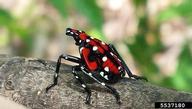Spotted Lantern Fly in NC
go.ncsu.edu/readext?936932
en Español / em Português
El inglés es el idioma de control de esta página. En la medida en que haya algún conflicto entre la traducción al inglés y la traducción, el inglés prevalece.
Al hacer clic en el enlace de traducción se activa un servicio de traducción gratuito para convertir la página al español. Al igual que con cualquier traducción por Internet, la conversión no es sensible al contexto y puede que no traduzca el texto en su significado original. NC State Extension no garantiza la exactitud del texto traducido. Por favor, tenga en cuenta que algunas aplicaciones y/o servicios pueden no funcionar como se espera cuando se traducen.
Português
Inglês é o idioma de controle desta página. Na medida que haja algum conflito entre o texto original em Inglês e a tradução, o Inglês prevalece.
Ao clicar no link de tradução, um serviço gratuito de tradução será ativado para converter a página para o Português. Como em qualquer tradução pela internet, a conversão não é sensivel ao contexto e pode não ocorrer a tradução para o significado orginal. O serviço de Extensão da Carolina do Norte (NC State Extension) não garante a exatidão do texto traduzido. Por favor, observe que algumas funções ou serviços podem não funcionar como esperado após a tradução.
English
English is the controlling language of this page. To the extent there is any conflict between the English text and the translation, English controls.
Clicking on the translation link activates a free translation service to convert the page to Spanish. As with any Internet translation, the conversion is not context-sensitive and may not translate the text to its original meaning. NC State Extension does not guarantee the accuracy of the translated text. Please note that some applications and/or services may not function as expected when translated.
Collapse ▲It was not a matter of if but a matter of when this unwelcome visitor would arrive. A little refresher on this insect invader, Spotted Lantern Fly (SLF) is a native of China, India, and South East Asia. SLF entered the United States via a shipment of Chinese landscape rock around 2014. Berks County, Pennsylvania (eastern portion of Pennsylvania) was the site of initial detection and identification. Since 2014 SLF has traveled to several additional states. Please see the attached map. The following is a list of SLF progression by state and year of detection: New Jersey (2018), Virginia (2018), Delaware (2019), West Virginia (2019), Maryland (2019), Connecticut (2019), New York (2020), Ohio (2020), Indiana (2021), and Massachusetts (2021). North Carolina is the latest state to identify an infestation of SLF on June 29, 2022 the North Carolina Department of Agriculture and Consumer service announced the discovery of SLF in Kernersville a suburb of Winston-Salem. Treatments and control measures are already underway in an effort to reduce SLF populations.
This expansion is a huge accomplishment for a plant hopper like SLF which are at best sub-par fliers in comparison to other insects. SLF relies on alien modes of transportation for travel such as vehicles, railroad cars, cargo, trailers, firewood, etc. it is suspected that SLF probably arrived in NC by rail. The grape industry has the most to lose in NC, because a vineyard infested with SLF can see reductions in yield of up to 90%. This insect does damage by piercing and sucking out plant nutrients and leaving behind frass (or honeydew) that molds or ferments which attracts wasps, ants, and other unwelcome guests. This infestation in regards to population numbers and the vast amount of frass generated greatly reduces photosynthetic activity thus weakening the plant which in turn leads to poor health and disease susceptibility. SLF feeds on fruit and native trees such as apples, plums, cherries, peaches, dogwoods, oaks, maples, and beeches. In fact, there are more than 100 species of plants that are susceptible to attack by SLF.

spotted lantern fly
The first step to control is understanding the life cycle. SLF has to have the Tree of Heaven (Ailanthus altissima/TOH) to reproduce due to metabolites produced by the TOH which are essential for life cycle completion. Eradication of TOH on one’s property is a good idea. Next month’s article will look at control methods for TOH other than sawing. Please resist the urge to cut this tree down; this typically leads to a vast number of suckers which in turn increases the TOH population. Also, examine your vehicle and purchases for egg masses when traveling. Please educate yourself about SLF detection and TOH identification; this can all be done via NC State Extension resources. A good place to start is the NC State Forestry Portal.



